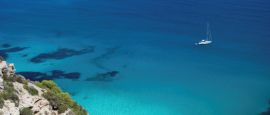Ibiza Weather, climate and geography
Weather & climate
With a Mediterranean climate, Ibiza enjoys mild winters and hot summers that can see temperatures exceeding 30ºC (86ºF) and an average of over 11 hours of sunshine per day. Rain tends to fall in the cooler winter months between October and December though occasional showers are not unusual at any time of year.
The high season runs from June to September, when temperatures are at their highest, and this is the best time to visit for the infamous Ibiza nightlife or beach holidays. To avoid the crowds, visit in May or October when the weather is still sunny, rain is rare, but the party season has either yet to begin or is coming to a close.
In winter, the temperature rarely drops under 0ºC (32ºF). From November to April, the average daytime temperature is about 15ºC (59ºF). However, when the sun comes out, this can rapidly climb to 25ºC (77ºF).
Geography
Ibiza is 571 sq km (220 sq miles), making it the third-largest of the Balearic Islands, an archipelago off the coast of Spain that includes Mallorca, Menorca, Ibiza (Eivissa) and Formentera. It is located in the Mediterranean Sea, 75km (46.6 miles) to the East of the Iberian Peninsula, 82km (51 miles) southwest of Mallorca and 87km (54 miles) away from the Alicante coast.
Despite only measuring approximately 35km (21 miles) in length at its longest point, and just 20km (12 miles) in width, Ibiza boasts two mountain ranges, both covered in thick, hardy woodland which inspired early Greek invaders to name Ibiza and neighbouring Formentera the Islas Pitiusas (Islands of Pine Trees). The Pitiusas are surrounded by over 60 small islets, such as S'Espardell, S'Espalmador and Penjats between Ibiza and Formentera, Es Vedrá, Es Vedranell, S'Espartar, Bosc, Bledes and Conillera in the southwest and Tagomago in the northeast.
The highest point of Ibiza is Atalaya of Sa Talaiassa de Sant Josep, at 475m (1,561ft), while the land to the south is the lowest point and consists of salt pans that have been exploited since ancient times and continue to be both an industry and tourist attraction. The most common crops grown are olives, figs and almonds. The long, often rugged coastline is peppered with a mixture of fine sandy beaches, pebbles, rocks and cliffs.
Do you have any Feedback about this page?
© 2025 Columbus Travel Media Ltd. All rights reserved. No part of this site may be reproduced without our written permission, click here for information on Columbus Content Solutions.




 You know where
You know where